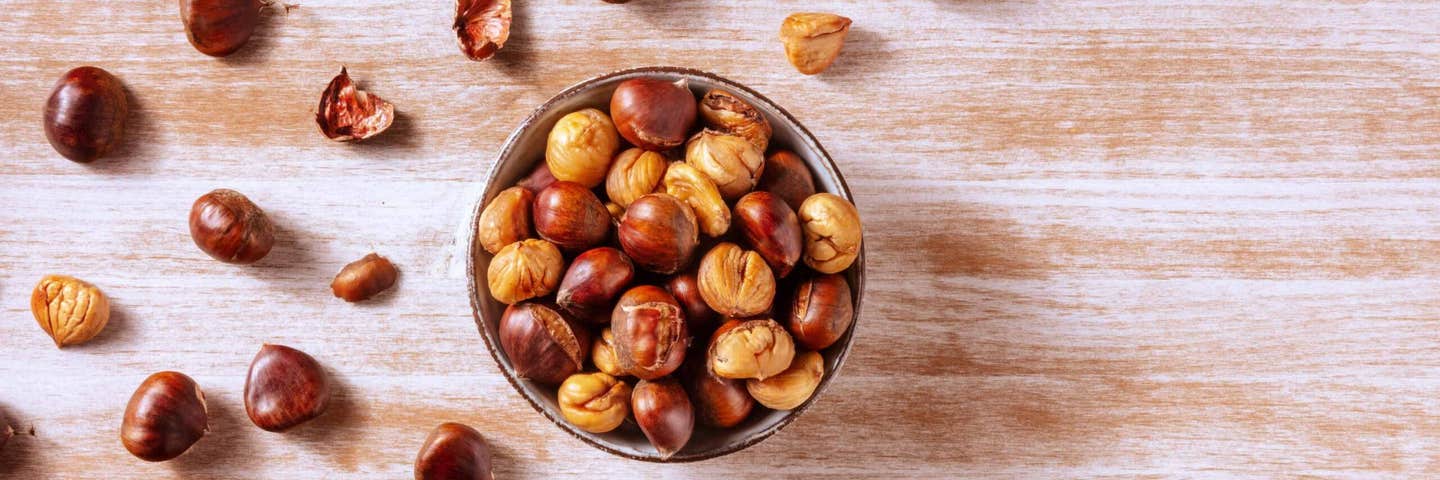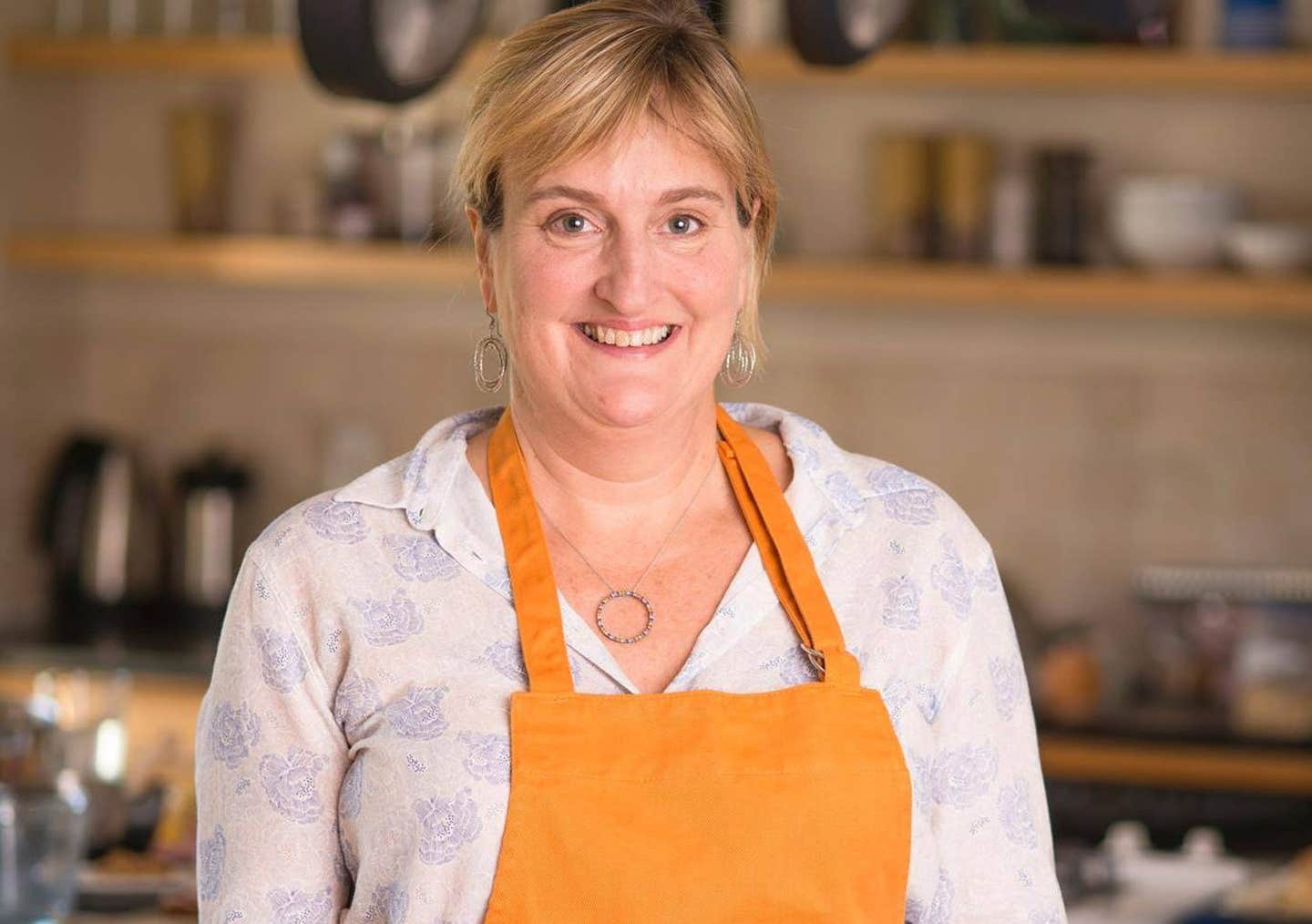
How to Cook Chestnuts 4 Ways, Plus Shopping, Storage, and Peeling Tips
Want to cook with chestnuts but don’t know where to start? Here’s a rundown on everything you need to know, including how to select, cook, and peel whole chestnuts and how to incorporate the sweet, tender treats to your favorite recipes.
What Are Chestnuts?
Chestnuts are shiny, round tree nuts related to acorns and beechnuts. They grow and mature inside spiny hulls, called burrs. In the fall, the burrs burst open to release one or two large, reddish-brown nuts that are rounded on one side. Beneath their thick, glossy skins, the nuts are encased in a thin inner pellicle, which needs to be removed before eating.
Chestnuts are native to Asia, Europe, and North America, though North American chestnuts have all but disappeared following a blight in the early 20th century. Nowadays, most of the chestnuts and chestnut products you’ll find in the U.S. are imported from Europe and Asia.
Once a highly nourishing “peasant food” that could be cooked and eaten or dried and ground into a flour, chestnuts have become a specialty ingredient often reserved for festive occasions.
When Are Chestnuts in Season?
Chestnuts hold a special place in holiday lore and cooking (chestnuts roasting on an open fire, anyone?), probably because their season coincides with the end-of-year festivities. Chestnuts are harvested from September to November and can usually be found through December. Jars and packages of ready-to-use whole, cooked chestnuts are available year-round.
What Do Chestnuts Taste Like?
Cooked chestnuts have a sweet, nutty, almost buttery flavor and a creamy texture like a potato. Chestnut flour ground from dried chestnuts is less sweet, with a slightly bitter, more robust taste.
Chestnuts vs. Other Nuts
Chestnuts are classified as tree nuts, but their sweet taste, creamy texture, and nutritional makeup are not like other nuts. Chestnuts are high in carbohydrates and fiber, low in fat and calories—1 ounce of cooked chestnuts has just 37 calories and less than 1 gram of fat compared with 185 calories and 18 grams of fat in an ounce of walnuts. Chestnuts’ high starch content means they’re also much more perishable than other nuts, both in the shell and cooked, and need to be refrigerated.
How to Roast, Boil, or Steam Fresh, Whole Chestnuts
Grab a knife or a pair of scissors (not a nutcracker!), choose the cooking method that suits you best, then peel and enjoy.
Step 1: Score and soak
Place each chestnut flat side down on a cutting board. Using a pair of scissors or a sharp knife, cut a long slit widthwise around the center (or belly) of each chestnut, cutting through the brown pellicle beneath the skin to reveal the flesh inside. Squeeze the chestnut to help the slit open further. Place scored chestnuts in a large bowl of cold water, then let them soak for 10 to 20 minutes to help soften the skin and loosen the pellicle.
Step 2: Cook
These four methods require different cooking times and yield slightly different results. Choose the one that works best for you or your recipe.
How to Oven-Roast Chestnuts
Best for: Snacking; using whole or chopped in salads, stuffings, and baked goods
Instructions: Preheat the oven to 400˚F. Spread the scored, soaked chestnuts on a baking sheet. Roast the chestnuts 25 to 30 minutes, or until the skins look dry and papery and have begun to retract from the scored cut.
How to Boil Chestnuts
Best for: Adding to all types of recipes; freezing
Instructions: Place scored, soaked chestnuts in a saucepan or the insert of an Instant Pot, and add enough water to cover by 1 inch. (Chestnuts float, so you may have to press them down with your hand to measure this.) Cover. Boil for 25 to 30 minutes, or until tender when squeezed. Alternately, cook on high pressure for 15 minutes in the Instant Pot, then allow the steam to naturally release. Drain.
Steaming Them in the Microwave
Best for: Cooking small quantities quickly to be used in stuffings and casseroles
Instructions: Place scored, soaked chestnuts in a single layer in a microwave-safe dish. Cook on high power, stirring after each minute for 5 to 7 minutes, or until the chestnuts are tender when squeezed.
How to Grill or Fire-Roast Chestnuts
Best for: Snacking
Instructions: Place scored, soaked chestnuts in a medium cast iron or other heavy-duty skillet and set on a grill or on a grate over the fire. Roast the chestnuts for 25 to 30 minutes, or until the skins are papery and beginning to blacken and the nuts are tender when squeezed.
Step 3: Peel
For chestnut skins and inner pellicles to come off easily, the nuts need to be warm. First, let the cooked chestnuts cool just until they are easy to handle, then place them in a covered dish or pan to keep them warm. Using a knife or your fingers, peel the chestnuts one by one, being sure to remove both the skin and inner pellicle.
How to Use Chestnuts in Recipes
One of the best things about chestnuts is how versatile they are in the kitchen. Cooked and peeled chestnuts can be blended into hearty soups (such as our Winter Potato-Leek Soup or Chestnut Soup), mashed with root vegetables (they’re especially good with sweet potatoes), or puréed with a little maple syrup for a toast spread. They can be added whole or chopped to stews, stir-fries, casseroles, and roasted vegetable medleys. And chestnuts can be used interchangeably with other nuts in baked goods: Try them in place of pecans in Pumpkin Spice Muffins!
How to Select and Store Chestnuts
Both fresh and prepared chestnuts have short storage lives. When buying fresh chestnuts, look for large, firm nuts with shiny skins that have no tiny holes from boring insects or white residue from mold. Store fresh, whole chestnuts for up to two weeks in an airtight container in the fridge or up to 6 months in the freezer.
Cooked chestnuts should be eaten within 3 days of cooking or opening the package, or frozen in a freezer-safe bag for later use.
About the Author

About the Author
Mary Margaret Chappell
Join our mailing list
Get free recipes and the latest info on living a happy, healthy plant-based lifestyle.
By providing your email address, you consent to receive newsletter emails from Forks Over Knives. We value your privacy and will keep your email address safe. You may unsubscribe from our emails at any time.
